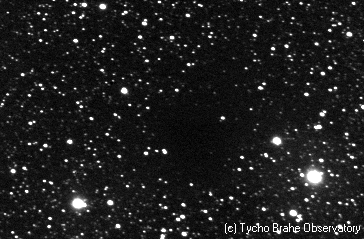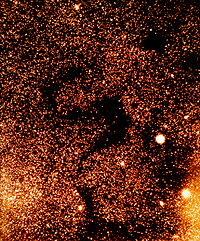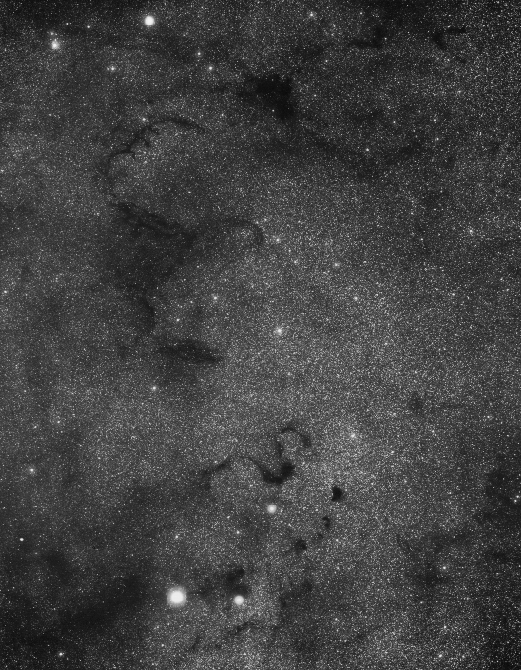
The dark nebulae are clumps or clouds that become opaque because of their internal dust grains. The form of such dark clouds is very irregular: they have no clearly defined outer boundaries and sometimes take on convoluted serpentine shapes. The largest dark nebulae are visible to the naked eye, appearing as dark patches against the brighter background of the Milky Way. An example is the Coalsack in the southern sky.

The hydrogen of these opaque dark clouds exists in the form of H2 molecules. The largest nebulae of this type, the so-called giant molecular clouds, are more than a million times as massive as the Sun. They contain much of the mass of the interstellar medium, are some 150 light-years across, and have an average density of 100 to 300 molecules per cubic centimetre and an internal temperature of only 7 to 15 K. Molecular clouds consist mainly of gas and dust but contain many stars as well. The cloud cores are completely hidden from view and would be undetectable except for the microwave emissions from their constituent molecules. This radiation is not absorbed by dust and readily escapes the cloud. The material within the clouds is clumped together in all sizes, with some clouds ranging down to the masses of individual stars. The density within the clumps may reach up to 105 H2 per cubic centimetre or more. Small clumps may extend about one light-year across. The clouds have an internal magnetic field that provides support against their own gravity.

Chemistry and physical conditions become quite different from those of the surrounding low-density interstellar medium. In the outer parts of the dark cloud, the hydrogen is neutral. Deeper within it, as dust blocks out an increasing amount of stellar ultraviolet radiation, the cloud becomes darker and colder. As the centre is approached, the predominant form of carbon changes successively from C+ (on the outside) to neutral C to finally the molecule carbon monoxide (CO), which is so stable that it remains the major form of carbon in the gas phase in the darkest regions. At great depths within the cloud other molecules can be seen from their microwave transitions, and more than 70 chemical species have been identified within the constituent gas. Owing to the comparatively low densities and low temperatures, the chemistry is very exotic, as judged by terrestrial experiments; some rather unstable species can exist in space because there is not enough energy to convert them to more stable forms. An example is the near equality of the abundances of the interstellar molecule HNC (hydroisocyanic acid) and its isomer HCN (hydrocyanic acid); in ordinary terrestrial conditions there is plenty of energy to allow the nitrogen and carbon atoms in HNC to exchange positions and produce HCN, by far the preferred species for equilibrium chemistry. In the cold clouds, however, not enough energy exists for the exchange to occur. There is less than one-thousandth as much starlight within a cloud as in the interstellar space outside the cloud, and the heating of the material in the cloud is provided primarily by cosmic rays. Cooling within the cloud occurs chiefly by transitions between low-lying levels of the carbon monoxide molecule.

In the inner regions of dark nebulae important events take place: the formation of stars. The discussion that follows will be slightly oversimplified by the assumption that a nebula has very little net rotation. Since the density in a star is immensely greater than that in a nebula, star formation must occur through condensation. The force of gravity in the nebula constantly pulls it together, working against the disruptive collisions of any one nebula or cloud with its neighbours and against the pressure provided by an internal magnetic field. But, even if gravity can hold the cloud together against other forces, the cloud cannot collapse unless it can cool; gravitational energy is released in a contraction and would heat the gas cloud, thus increasing the outward pressure and preventing further collapse. The dust grains are efficient emitters of infrared radiation, which escapes, removing the energy from the nebula. A cloud, therefore, contracts under its own gravity, radiating away half of the gravitational energy of the contraction, the other half going into heating the gas. As it contracts, the density and gravitational binding increase until finally the cloud's gravity so dominates the internal pressure that the material rushes inward in almost a free fall.

While the entire cloud has been collapsing, it does not have a smooth density distribution but rather consists of a chaotic jumble of smaller clouds. These cloudlets pull themselves together by their own gravity into "protostars," each of which is destined to be an individual stellar system. Most of these protostars are smaller than one solar mass, but a very few may be several (up to about 100) times as massive as the Sun. These few massive stars have a profound influence in the evolution of the nebula.
Each protostar collapses very quickly; its gas falls inward in free fall. A protostar can collapse from a size equal to the outer diameter of the solar system to about 30 times the Sun's size (the size of Mercury's orbit) in about six months. After it reaches that size, the material becomes so hot it has become a star--that is, an opaque body radiating energy only from its surface. Around it is a whirling ring of cold, dusty material, which will also break up into even smaller fragments, the "protoplanets." It is now believed that planetary systems are made out of this dusty chaos.
Such newly formed stars continue to contract, becoming hotter but less luminous in the process, until they start to produce heat by converting hydrogen into helium rather than by contracting. If massive enough, a star ionizes the nebular material, producing a bright nebula around it.
These ideas are given encouraging confirmation by observations of dark nebulae in very long wavelength infrared radiation. Some of the brightest infrared sources are associated with such dark dust clouds; a good example is the class of T Tauri variables, named for their prototype star in the constellation Taurus. The T Tauri stars are known for a variety of reasons to be extremely young. The variables are always found in or near dark nebulae; they often are also powerful sources of infrared radiation, corresponding to warm clouds of dust heated by the T Tauri star to a few hundred kelvins. There are some strong infrared sources (especially in the constellation of Orion) that have no visible stars with them; these are presumably "cocoon stars" completely hidden by their veils of dust.
Excerpt from the Encyclopedia Britannica without permission.